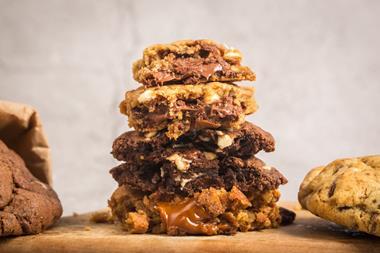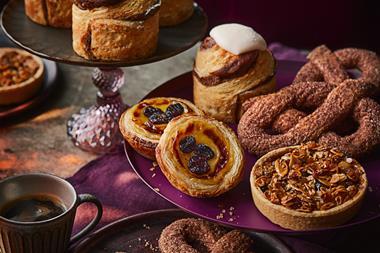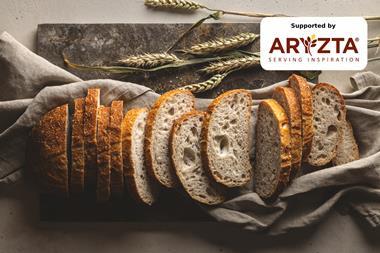Health-conscious UK shoppers are showing ongoing interest in ‘breads with bits’... and the sales figures suggest suppliers should embrace this
Underestimate the significance of ‘bread with bits’ at your peril.
Value sales of loaves with added seeds and high fibre rose by 11% to £276m in 2017 (Mintel), helping drive a renaissance in wrapped bread that, following years of value decline, grew 4.3% in value and 0.3% in volume (Kantar Worldpanel 52 w/e 31 December 2017).
“While the wider category is in long-term decline, recent value and volume increases are being almost wholly driven by the double-digit growth of the seeds and grains sector,” says Roberts Bakery MD Stuart Spencer-Calnan, adding that seeded products command a price premium.
Chief among the factors driving Britain’s growing appetite for pricier, seeded and high-fibre bread and baked goods is the healthy image such products have.
“Seeds are a simple and tasty way to add protein, fibre, antioxidants and good fats into meals and diets – all while delivering great taste and texture,” says Délifrance UK marketing director Stéphanie Brillouet.
Protein, fibre, antioxidants and good fats are all buzzwords among today’s health-conscious consumers, and marketers and product developers in the baking sector are taking notice. But, according to Edme sales director Mike Carr, more could be done to realise the opportunity. “Bread with bits is now the second-biggest market segment in pre-packed bread,” he says. “The growth in breads and other baked goods containing seeds, flakes and kibbles is encouraging.”
In the year to August 2017, seeds featured in 3% of bread and baked goods launches globally, up from 1% four years earlier (Mintel). Much of this innovation was in Europe, says Bakels marketing manager Michael Schofield.
“Europe accounted for 40% of flavoured bread and bread product innovation in the 12 months to August 2017, so we may expect further seeded bread varieties in both wrapped and craft bakeries in coming years,” he says.
Indeed, the big three wrapped bread brands have been putting greater focus on seeds of late, with Warburtons unveiling its Pulses & Seeds Batch Loaf earlier this year and Hovis claiming its Seeds Sensations Original Seven Seeds loaf is in 16.6% growth as a result of growing consumer demand for bread with bits.
Allied launched Kingsmill Super Seeds in 800g and 400g loaves in the new year to tap the trend. “Made with a variety of seeds, including linseed, sunflower, poppy and pumpkin, it is not only a source of fibre but is also a great source of Omega 3 alpha-linolenic acid, which helps maintain healthy levels of cholesterol,” says Allied category director Zoe Taphouse.
%%Quote_34%%
Now, health-conscious shoppers are starting to look for more exotic offerings in seeded and high-fibre loaves.
“Seeds that are under-utilised, or unknown to consumers, can be added to a mix containing more common seeds to bring taste and health benefits,” says Carr. “An example is Edme’s new range of seed mixes and toppings, utilising less popular seeds such as kalonji (also known as nigella) and putting in a mix alongside more commonly known seeds such as millet and sunflower.”
Délifrance’s Brillouet agrees: “While the classic favourites, such as sesame and poppy, still have their place, operators looking to stand out need to embrace what’s growing on the seed scene,” she explains. “Flax, chia, pumpkin, nigella, sunflower and quinoa… the opportunities are endless.
“Seeds aren’t just sitting atop loaves any more, they can be included in the dough. It’s a simple change, but it brings a crunch of texture, flavour and wellness to every bite.”
Ancient grains, sprouted grains and pulses are also being put into the mix. Délifrance’s Feel Good range includes breads with ancient grains and a half baguette with chickpeas, tomato & quinoa as well as a spelt boule, for example. Bridor’s Finedor range includes spelt, chia, amaranth, red quinoa and millet.
“Each offers a host of health benefits ranging from improving digestion to boosting immunity. For example, amaranth is rich in calcium, iron, and potassium,” notes Bridor northern Europe sales director Erwan Inizan. “And millet has a high magnesium content to help maintain a healthy heart.”
Meanwhile, CSM Bakery Solutions claims to be the only supplier offering ancient grains emmer and einkorn – the former is a type of hulled wheat known as farro in Italy, the latter an unhybridised ancient form of wheat – in its Pantique Ancient Grains bread mix. “These premium grains require a specialist milling process and CSM has developed a close relationship with farmers and millers to ensure the product is of a high quality,” says product marketing director Miriam Bernhart. “Consumers expect to pay up to 50% more for ancient grains bread than standard bread.”
It’s not just the purported health benefits of such ingredients that are fuelling their rise. Flavour is also paramount, says Lydia Baines, marketing manager at Puratos, which positions its Sprouted Grains mix as a convenient way for bakers to tap growing demand for more exotic ingredients.
“Due to the activation of endogenous enzymes, complex starch molecules are transformed into simple oligosaccharides and sugars – this transformation adds natural sweetness to the products in which sprouted grains are applied,” she says.
Sprouted grains are also high in fibre, and there is a clear argument for consumers to get more fibre in the bread they eat.
“UK consumers are suffering from a lack of fibre in their diets, with men needing to increase their fibre consumption by 50% and women by 75%,” says Baines. “With seeds an excellent source of fibre, adding them to bakery products is a great way to boost fibre content and, in turn, consumer interest.”
And right now the bread sector needs more of that almost as much as British consumers need more fibre.
Using seeds in sweet bakery
In this age of carb-dodging, gluten intolerance and sugar demonisation, producers of baked sweet treats are battling some pretty stiff headwinds.
“The impact of some health crazes and celebrity fad diets has had a negative impact on the way consumers view baked bread products and sweet goods,” says EHL Ingredients joint MD Tasneem Backhouse.
But they have some powerful tricks up their sleeves: seeds. Just look at the explosive growth of snack brands such as Bounce Energy, 9Bar and Eat Natural – all of which trumpet the health credentials of the seeds their products contain – to see how potent a force seeds can be in making sweet treats permissible.
So a growing number of bakers are adding seeds into the mix when creating cakes, muffins and biscuits.
“Seeds can be added to a whole host of sweet baked products, including flapjacks, cookies, crackers and biscuits, protein balls, health and nutrition bars. While they visually enhance the health credentials of baked goods, most are an added source of protein, fibre and Vitamin E,” adds Backhouse.
EHL reports strong sales of pumpkin, chia, quinoa, sunflower, flax and sesame seeds to bakers looking to boost their sweet treats with the added nutritional qualities these products contain. Items containing such ingredients strike a particular chord with time-pressed punters looking for a sweet, yet more health-orientated start to the day, according to Stuart New, head of bakery at Rich Products.
“We’re developing recipes using linseed, pumpkin seeds, and sunflower seeds in combination with ancient grains such as spelt to deliver those health benefits, without compromising on taste,” says New. “Breakfast is key for this type of product as consumers look to start the day off in ‘healthy mode’.
“The Oaty Jam Bake that we launched recently for a leading coffee shop chain is a good example of innovation in this space – not only is it designed as a high-fibre ‘healthful’ product, which is topped with seeds, made with spelt flour, and fully vegan certified – but it tastes great too, so is healthy and treat-like in equal measures.”
Spotlight on global NPD
Modern Hi Fibre Brown
- India
- This comes with the claim that it can aid digestion with added fibre and protein. It contains no artificial colours, cholesterol or trans fats, according to Modern, which also produces Multigrain, premium Atta Shakti and Oat & Flax loaves.
Brownberry 22 Grains & Seeds
- US
- This organic loaf has no artificial colours, flavours, preservatives or high-fructose corn syrup. It contains 22 types of grains and seeds, ranging from wheat, pumpkin seeds and millet to sorghum, quinoa, kamut, kaniwas seeds and amaranth.
Albany Bread A Betix Low GI Seeded Brown Bread
- South Africa
- This loaf aims to help consumers manage blood sugar levels. The baker claims two- thirds of women and a third of men in the country are overweight or obese, risking heart disease, strokes and type 2 diabetes.
Ole Mexican Foods Spinach & Herbs Tortilla Wraps
- US
- As well as spinach & herbs, these contain added wheat fibre and flax seeds. They join a portfolio of other health-orientated tortilla wraps, including Extreme Fibre and Carb Counter Wholewheat.
Fibre’s role in reducing sugar
Interest is growing in the use of fibres derived from sources including oats to help reduce sugar in baked goods.
“Fibre compensates for the lack of bulk and texture and allows for a satisfying sensory experience in reduced-sugar and reduced-calorie formulations,” claims Nancy Gaul, global marketing director for Tate & Lyle.
Such fibres, oligosaccharides, are long chains of sugars that do not deliver the same amount of calories as glucose or fructose. “More complex sugars take longer to be digested and are less likely to be stored as fat if it is not needed,” says Andrzej Swiderski, general manager of Gradz Bakery, which uses dietary fibre inulin in some of its sweet treats.
But reducing calories is more involved than simply replacing sugar with a more complex form. “We’ve worked with our customers on sugar reduction, and learnt pretty early on that it isn’t as straight-forward as replacing sugar with something else such as inulin or oat fibre,” says Rich Products head of bakery Stuart New. “It involves rebalancing the whole recipe to ensure the consumer is still getting the great-tasting product they expect.”
Rising to the challenge
While driving growth in the bread market, the use of ingredients such as seeds and sprouted grains is not without its challenges.
With more seeds being added to the mix, there is a higher chance of particulates being thrown from the process, making clean-downs following a bake a lengthier and more resource-intensive process. There are also potential issues when it comes to slicing and packaging products containing seeds and grains (see slicing feature, p41).
Signature Flatbreads invested £10m in a new bakery in 2016 to help it tap demand for high-fibre and seeded flatbreads.
“Using such ingredients does cause issues in manufacturing, but these are far outweighed by the consumer perception of the health benefits, so we are tackling and resolving these with the help of factory technology and the bakery expertise we have,” says Tim Wittekind, head of NPD and innovation at Signature.
Then there’s the ultimate challenge for any baker: making sure the addition of any new-fangled (or indeed ancient) ingredients results in a product consumers want to eat.
“As my professor used to say, the simplest things are often the most difficult to do well,” says Andrzej Swiderski, general manager of Gradz Bakery.
“When your ingredients are just water, salt, flour and seeds, people might say it’s not complicated to bake something delicious and healthy. Not so. The proportions you use are very important.
“Amaranth has an earthy taste, so if you use too much people might think it tastes mouldy. Fibre holds moisture and a benefit of seeded bread can be that it is moist, but get the proportions wrong and it can be too wet.”


























No comments yet